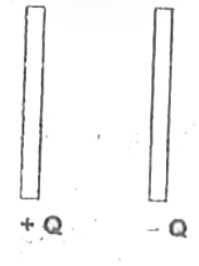The electrostatic force between the metal plate of an isolated parallel plate capacitor C having charge Q and area A, is
Proportional to the square root of the distance between the plates
Linearly proportional to the distance between the plates
Independent of the distance between the plates
Inversely proportional to the distance between the plates.
The correct Answer is:C
To find the electrostatic force between the metal plates of an isolated parallel plate capacitor with capacitance C, charge Q, and area A, we can follow these steps:
1. Understand the Concept of Electric Field:
The electric field E between the plates of a parallel plate capacitor can be expressed in terms of the surface charge density σ. The surface charge density is given by:
σ=QA
where Q is the charge on one plate and A is the area of the plates.
2. Calculate the Electric Field:
The electric field E between the plates of a parallel plate capacitor is given by:
E=σϵ0
where ϵ0 is the permittivity of free space. Substituting σ:
E=QAϵ0
3. Determine the Force on a Charge:
The electrostatic force F acting on a charge Q in an electric field E is given by:
F=Q⋅E
Substituting the expression for E:
F=Q⋅(QAϵ0)
Simplifying this gives:
F=Q2Aϵ0
4. Analyze the Dependence on Distance:
From the derived formula for force F, we observe that there is no term involving the distance d between the plates. This indicates that the force is independent of the distance between the plates.
5. Conclusion:
Therefore, the electrostatic force between the metal plates of an isolated parallel plate capacitor is independent of the distance between the plates.
Final Answer:
The electrostatic force between the metal plates of an isolated parallel plate capacitor is independent of the distance between the plates.
The electric field E between the plates of a parallel plate capacitor can be expressed in terms of the surface charge density σ. The surface charge density is given by:
σ=QA
where Q is the charge on one plate and A is the area of the plates.
The electric field E between the plates of a parallel plate capacitor is given by:
E=σϵ0
where ϵ0 is the permittivity of free space. Substituting σ:
E=QAϵ0
The electrostatic force F acting on a charge Q in an electric field E is given by:
F=Q⋅E
Substituting the expression for E:
F=Q⋅(QAϵ0)
Simplifying this gives:
F=Q2Aϵ0
From the derived formula for force F, we observe that there is no term involving the distance d between the plates. This indicates that the force is independent of the distance between the plates.
Therefore, the electrostatic force between the metal plates of an isolated parallel plate capacitor is independent of the distance between the plates.
The electrostatic force between the metal plates of an isolated parallel plate capacitor is independent of the distance between the plates.
Similar Questions
Knowledge Check
As the distance between the plates of a parallel plate capacitor decreased
AIf both assertion and reason are ture and reason is the correct explanation of assertion.BIf both assertin and reason are ture but reason is not the correct explanation of assertion .CIf assertion is true but reason is false.DIf both assertion and reason are false.
Force of attraction between the plates of a parallel plate capacitor is
View SolutionIf the plates of a parallel plate capacitor are not equal in area, then
View SolutionA parallel plate capacitor is charged. If the plates are pulled apart
View SolutionThe separation between the plates of a charged parallel-plate capacitor is increased. The force between the plates
View SolutionThe force between the plates of a parallel plate capacitor of capacitance C and distance of separation of the plates d with a potential difference V between the plates, is.
View SolutionThe expression for the capacity of the capacitor formed by compound dielectric placed between the plates of a parallel plate capacitor as shown in figure, will be (area of plate =A)

View SolutionAssertion: A dielectric slabis inserted between plates of an isolated capacitor. charge on capacitor will remain same.
Reason Charge on an isolated system is conserved.
View Solution

